Electroplating is the process of coating one metal object with another. It works by electrolysis, which is when electricity is used to drive a chemical reaction. Today, we’re going to look at why you’d want to electroplate, how it works and various conditions that need to be considered when electroplating. This article is focusing on why we need electroplating, how does electroplating works, as well as what things to consider in electroplating.

Why Do We Need Electroplating?
Metals maybe electroplated for aesthetics protection or both. Aesthetics might involve making a metal shinier or giving it an attractive color by coating. For example, jewelry is often plated gold or silver. A metal coating can be used for protection as it may help resist corrosion rusting or just general wear and tear. Car rims are electroplated for both shininess and protection. Chromium commonly known as chrome, nickel, tin, zinc and cadmium are often used to play copper iron and steel objects. Tin cans are actually made of steel but have a thin tin coating and white the astronaut who made the first American spacewalk in 1965 was wearing a gold-plated visor to protect his eyes from the solar radiation.
How Does Electroplating Work?
An electric current is passed through a solution that conducts electricity, could an electrolyte to create this current. Two electrodes dipped into the electrolyte solution and connected to a battery or power supply. When the current is turned on, the electrodes gain a charge. The positively charged electrode is called the anode and the negatively charged electrode is called the cathode. The electrodes and electrolyte are carefully chosen based upon what metal you are plating with. If you want to copy plate another metal, you will use a copper based electrolyte solution and have a copper anode. The copper for the plating comes from the electrolyte solution which in turn has it stops replenished by the copper anode.
Copper Plating
Look at copper plating as an example, we want to copy place and brass, so we have a copper anode, a brass cathode and a copper based solution for the electrolyte. Copper sulfate solution contains blue copper ions and colorless sulfate ions. The copper ions are positively charged and so attracted to the negatively charged brass cathode. The copper ions deposit onto the brass, producing the thin copper plate. The positively charged copper ions gain electrons, which is known as reduction. The sulfate ions are negatively charged and so are attracted to the positively charged copper anode. The current supplied to the anode causes the copper atoms to oxidize, which is lost electrons and then dissolve into the electrolyte solution. The copper ions move from the anode to the cathode in the solution, and the electrons move from the anode to the cathode but along the wire.
The copper anode bug gradually dissolves to replenish the copper ions in the electrolyte solution. The solution stays at the same concentration if another matter was used at the anode, then the copper sulfate solution would get paler or less concentrated. Oxidation the loss of electrons takes place at the anode and reduction the gain of electrons take place at the cathode.
Few Other Things To Consider In Electroplating
The speed at which electroplating requires depends only upon the strength of the electric current. A stronger current increases the speed at which the ions and electrons move through the circuit. Speeding up the plating process one way to increase the current is by increasing the concentration of ions in the solution.
It is also important to choose your metals carefully in electroplating. Not all metals will alloy with each other. For example, steel has to be copper plated and then silver-plated, because it will not form a direct alloy with silver. There are also environmental concerns associated with some metals. Chrome plating creates waste materials which are dangerous to humans and animals. Wears products have to be treated accordingly to make sure they are safe which can be very expensive.
Most importantly, for current to flow, Electrophoresis the ions need to be able to move. Therefore, the compound must be molten or dissolved in a solution. In conclusion, you should understand how electroplating works using electrolysis. When the current blows the positive ions in the electrolyte solution move towards a negative cathode where they gain electrons which is reduction, this is what causes the plating to occur. At the anode the current causes the metal atoms to lose electrons and dissolve into the electrolyte solution. The electrons which the metal atoms lose, flowed back to the power source and around to the cathode losing electrons at the anode is known as oxidation. Make sure to remember, we have reduction at the cathode and oxidation. At the anode, and that’s electroplating.

